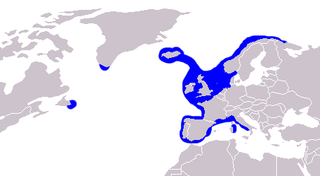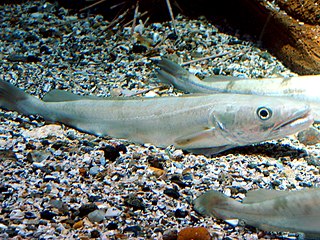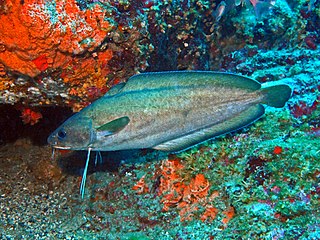
The common ling, also known as the white ling or simply the ling, is a large member of the family Lotidae, a group of cod-like fishes. It resembles the related rocklings, but it is much larger and has a single barbel. This species is unrelated to the pink ling, Genypterus blacodes, from the Southern Hemisphere. The common ling is found in the northern Atlantic, mainly off Europe, and into the Mediterranean Basin. It is an important quarry species for fisheries, especially in the northeastern Atlantic, although some doubts exist as to the sustainability of the fisheries. As an edible species, it is eaten fresh, frozen, or dried, but also preserved in lye, while the roe is a delicacy in Spain.

The North Pacific hake, Pacific hake, Pacific whiting, or jack salmon is a ray-finned fish in the genus Merluccius, found in the northeast Pacific Ocean from northern Vancouver Island to the northern part of the Gulf of California. It is a silver-gray fish with black speckling, growing to a length of 90 cm (3 ft). It is a migratory offshore fish and undergoes a daily vertical migration from the surface to the seabed at depths down to about 1,000 m (3,300 ft). It is the object of an important commercial fishery off the West Coast of the United States, and annual quotas are used to prevent overfishing.

The silver hake, Atlantic hake, or New England hake is a merluccid hake of the genus Merluccius, found in the northwest Atlantic Ocean. It is highly predatory and typically feeds on fish and crustaceans.

The Australian sawtail catshark is a common species of catshark, and part of the family Scyliorhinidae, endemic to southern Australian waters. It is found on or near the bottom of the outer continental shelf and upper continental slope, at depths of 85 to 823 m. This slim-bodied species is characterized by crests of enlarged dermal denticles along both the dorsal and ventral edges of its caudal fin and caudal peduncle, along with a color pattern of broad, dark saddles outlined in white. It can grow to 61 cm (24 in) in length. The Australian sawtail catshark feeds mainly on fishes, crustaceans, and cephalopods. Females are oviparous and lay eggs enclosed by capsules. This species is often caught incidentally by commercial bottom trawl fisheries, but is not significantly threatened by fishing activity. Thus, it has been assessed as of Least Concern by the International Union for Conservation of Nature (IUCN).

The African sawtail catshark is a species of catshark, part of the family Scyliorhinidae. Demersal in nature, it is found at depths of 160–720 m (520–2,360 ft) off the western African coast from Morocco to South Africa. This slender species has a rather long, pointed snout, a series of dark saddles along the back and tail, and a prominent crest of enlarged dermal denticles along the upper edge of the caudal fin. Its maximum known length is 46 cm (18 in).

Gadella is a genus of morid cod. The species in this genus are characterised by the absence of a chin barbell, an anterior dorsal fin with 7-11 rays, a long based anal fin which has a straight profile, the outermost rays of the pelvic fin are filamentous and extend a small distance beyond the membrane. They do not have a photophore. The Gadella codlings are found around the tropical and subtropical seas around the world on the outer continental shelf to the mid continental slope. They are of no interest to fisheries.

The European pilchard is a species of ray-finned fish in the monotypic genus Sardina. The young of the species are among the many fish that are sometimes called sardines. This common species is found in the northeast Atlantic, the Mediterranean, and the Black Sea at depths of 10–100 m (33–328 ft). It reaches up to 27.5 cm (10.8 in) in length and mostly feeds on planktonic crustaceans. This schooling species is a batch spawner where each female lays 50,000–60,000 eggs.

Merluccius merluccius, the European hake, is a merluccid hake of the genus Merluccius. Other vernacular names include Cornish salmon and herring hake. It is a predatory species which was often netted alongside one of its favoured prey, the Atlantic herring, thus the latter common name. It is found in the eastern Atlantic from the Norway and Iceland south to Mauritania and into the Mediterranean Sea. It is an important species in European fisheries and is heavily exploited with some populations thought to be being fished unsustainably.

Merluccius capensis is a ray-finned fish in the genus Merluccius, found in the south-eastern Atlantic Ocean, along the coast of South Africa. It is a long, lean fish with a large head, similar in appearance to the European hake and the deep-water Cape hake. By day, it lives close to the bottom on the continental shelf and upper slope at depths not usually exceeding 400 m (1,300 ft); it makes a large, daily vertical migration rising at night to feed in the nectonic zone, and it also migrates southwards in spring and northwards in autumn. It is an important commercial fish species in southern Africa.
The Panama hake, also known as the dwarf hake, is a merluccid hake found off the west coast of the Americas from Del Mar, California, to Ensenada de Tumaco, Colombia.

Phycis phycis, the forkbeard, is a species of phycid hakes in the family Phycidae.

Coelorinchus caribbaeus, the blackfin grenadier, is a member of the family Macrouridae. It is a marine benthopelagic rattail. It has a wide range in the western tropical Atlantic. It lives in depths of 200 meters to 700 meters
The thinlip splitfin is a species of fish in the family Acropomatidae, the lanternbellies. It lives around Africa's Atlantic coast at a depth of 50–500 m and can grow up to 16.5 cm long.

Trachyrincus scabrus, the roughsnout grenadier or Mediterranean longsnout grenadier, is a species of bathydemersal marine fish from the subfamily Trachyrincinae, part of the family Macrouridae. It is found in the eastern Atlantic Ocean and the Mediterranean.
Merluccius australis, the southern hake, is a species of fish from the family Merlucciidae, the true hakes. It is found in the southern Pacific and Atlantic Oceans with two disjunct populations, one around southern South America and the other in the waters around New Zealand.
Merluccius hernandezi, the Cortez hake, is a species of fish from the family Merlucciidae, the true hakes. It is endemic to the Gulf of California where it can be found in the epipelagic and mesopelagic zones over the continental shelf, open sea, and sea mounts, to a depth of around 300m. It is a small species which has been referred to as a "dwarf hake" and is of little interest to fisheries, other than small scale local fisheries. It was described in 1985 and small hake in the Gulf of California were previously considered to be Panama hakes. This species differs from the Panama hake in that in juveniles the caudal fin has a central lobe and is truncate in adults, whereas the caudal fin is emarginate in the Panama hake, its pectoral fin projects well beyond the anus in but does not do so in the Panama hake.
Merluccius polli, the Benguela hake, is a species of fish from the family Merlucciidae, the true hakes. It is found in the tropical waters of the eastern Atlantic Ocean off the west coast of Africa.

Gadella maraldi, the gadella or morid cod, is a species of fish in the family Moridae from the warmer waters of the north eastern Atlantic Ocean and the Mediterranean Sea.
The spearsnouted grenadier is a species of fish in the family Macrouridae.
Lyconus brachycolus is a species of hake fish in the family Merlucciidae.













